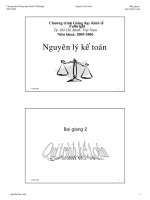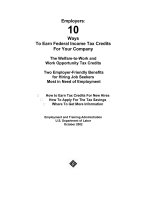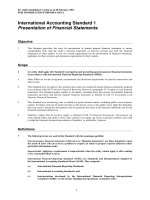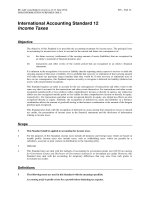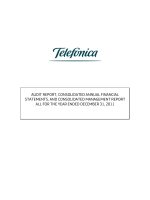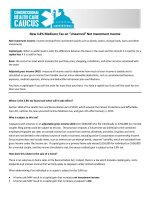Income statements
Bạn đang xem bản rút gọn của tài liệu. Xem và tải ngay bản đầy đủ của tài liệu tại đây (394.58 KB, 38 trang )
Understanding Income
Statements
Financial Skills
Team FME
www.free-management-ebooks.com
ISBN 978-1-62620-955-8
Copyright Notice
© www.free-management-ebooks.com 2013. All Rights Reserved
ISBN 978-1-62620-955-8
The material contained within this electronic publication is protected under International
and Federal Copyright Laws and treaties, and as such any unauthorized reprint or use of
this material is strictly prohibited.
You may not copy, forward, or transfer this publication or any part of it, whether in electronic or printed form, to another person, or entity.
Reproduction or translation of any part of this work without the permission of the copyright holder is against the law.
Your downloading and use of this eBook requires, and is an indication of, your complete
acceptance of these ‘Terms of Use.’
You do not have any right to resell or give away part,
or the whole, of this eBook.
UNDERSTANDING INCOME STATEMENTS
Table of Contents
Preface
2
Visit Our Website
3
Introduction
4
Purpose of the Income Statement
5
Income Statement Formats
7
The Single-Step Format
7
Revenues
9
Expenses
10
Net Income
12
Multiple-Step Income Statement
13
Importance of Transaction Timing
16
Other Operating Expenses
18
Other Generic Terms
21
Using Income Statements Effectively
Income Statements in Comparative Formats
22
22
Comparison of Annual Figures
23
Comparison of Annual Figures with Percentage Change
24
Annual Percentage Comparison
26
Common-Size Statements
27
Performing a Common-Size Analysis
30
Comparison with Cash Flow Statements
32
Summary
34
Other Free Resources
36
References
36
ISBN 978-1-62620-955-8 © www.free-management-ebooks.com
1
UNDERSTANDING INCOME STATEMENTS
Preface
This eBook you will give you a thorough understanding of the income statement, a powerful decision-making tool that every manager should be familiar with.
You will learn:
How an income statement is prepared and what it can tell you
The importance of transaction timing and how it inluences the income statement
totals
How to use accounting standards to help you deine operating and non-operating
expenses
How to use income statements to measure inancial performance against expectations
How to compare income statements for different sized organizations
ISBN 978-1-62620-955-8 © www.free-management-ebooks.com
2
UNDERSTANDING INCOME STATEMENTS
Visit Our Website
More free management eBooks along with a series of essential templates and checklists for managers are all available to download free of charge to your computer, iPad, or
Amazon Kindle.
We are adding new titles every month, so don’t forget to check our website regularly for
the latest releases.
Visit
ISBN 978-1-62620-955-8 © www.free-management-ebooks.com
3
UNDERSTANDING INCOME STATEMENTS
Introduction
As a manager, you may be asked to produce or contribute towards an income statement
for your own business unit. This provides senior management with an indication of how
your business unit is performing against its targets over a speciic period, for example
quarterly. This eBook you will give you a thorough understanding of the income statement and how it is made up.
The purpose of an income statement is to be able to measure an organization’s inancial
performance over a speciic accounting period. It provides a summary of how its revenues and expenses are incurred, as well as showing if it has made a net proit or loss.
Income
Statement
consists of:
Operating
Items
Nonoperating
Items
The income statement is divided into two parts:
Operating items section—provides information about revenues and expenses
that are a direct result of regular organization operations.
For example, if an organization sells garden furniture, then the operating items
section would detail the revenues and expenses involved with the manufacture, buying in, and retailing of garden furniture.
Non-operating items section—details any revenue and expense information
about activities that are not tied directly to these operations.
In the garden center example, if they purchased a warehouse or more land
then this information would be detailed in the non-operating items section.
All the income statements in this eBook are produced based on the accrual method of accounting. You will need to have a basic understanding of this method and other commonly
used inancial terms to maximize the beneits you will obtain from studying this eBook.
If you are unfamiliar with or unsure of the exact meaning of ‘accrual’ or other commonly used
inancial terms, you can ind a simple explanation for them in our free eBook ‘Accounting
Principles.’ You can download this eBook by visiting www.free-management-ebooks.com.
ISBN 978-1-62620-955-8 © www.free-management-ebooks.com
4
UNDERSTANDING INCOME STATEMENTS
Purpose of the Income Statement
The primary purpose of the income statement is to report an organization’s earnings to
investors over a speciic period of time. It provides important insights into how effectively management is controlling expenses, the amount of interest on income and expense,
and the taxes paid.
Income Statement’s
purpose
Assess management’s
ability to control
Expenses operating
& non-operating
Provide investors
Report on earnings
over a certain period
Level of interest on
income & expense
Taxes paid
Income statements are used in a variety of ways both internally and externally to aid the
decision-making process. For example:
To show how well management is investing the money under its control.
To enable comparisons to be made with an organization’s competitors.
To assess an organization’s operating performance over a deined period.
To determine the type of investment opportunity the organization represents.
An income statement can also be used to calculate inancial ratios that will reveal how
well the management is investing the money under their control. It can also be used to
compare an organization’s proits with those of its competitors by examining various
proit margins.
Your role as a manager is likely to ind you using an income statement to track revenues
and expenses so that you can determine your operating performance for the organiza-
ISBN 978-1-62620-955-8 © www.free-management-ebooks.com
5
UNDERSTANDING INCOME STATEMENTS
tion over a period of time. You can also use it to track increases in product returns or cost
of goods sold as a percentage of sales.
Assess management’s
financial abilities
Determine the
type of investment
opportunity it presents
An organization’s
income statement is
used to:
Make comparisons with
its competitors
Assess its operating
performance
An income statement also allows potential lenders, banks, or investors to assess what
type of investment your organization would be for them. These people would also want
to look at your organization’s balance sheet.
Existing and potential suppliers are interested in reviewing income statements because
this helps them to assess what type of credit terms they are prepared to offer your organization—for example, whether or not to ask for pre-payment before they will supply
you, or whether to restrict your credit limit.
KEY POINTS
4
The primary purpose of the income statement is to report an organization’s
earnings to investors over a speciic period of time.
4
It can also be used to judge how well the organization is managed inancially;
decide the type of investment opportunity it presents; make comparisons
with its competitors; and assess its operating performance.
ISBN 978-1-62620-955-8 © www.free-management-ebooks.com
6
UNDERSTANDING INCOME STATEMENTS
Income Statement Formats
There are a variety of different types of income statements that organizations use, but
the most common are:
Single-step format
Multi-step format
Singlestep
Multistep
The most
common
income
statement
formats
The following sections take you through how each of these formats is produced and what
is included in each one.
The Single-Step Format
This format for the income statement uses only one subtraction to arrive at net income.
Taking away the sum of expenses and losses from the sum of revenues and gains gives
a igure for net income.
Revenue +
Gains
Expenses +
Losses
ISBN 978-1-62620-955-8 © www.free-management-ebooks.com
Net
Income
7
UNDERSTANDING INCOME STATEMENTS
The table below shows you what an income statement created in this way would look
like. Then there is an explanation for each of the main sections.
Gary’s Garden Furniture
Income Statement
January 1—December 13, 2013
$
REVENUES
Sales
Interest Revenues
Gains
Total Revenues
EXPENSES & LOSSES
Cost of Goods Sold
Salaries
Rent
Utilities
Interest Expense
Losses
Bad Debt Provision
Depreciation
Total Expenses & Losses
$
350,000
1,000
2,000
353,000
125,000
110,000
7,000
2,000
1,000
1,000
4,000
8,000
NET INCOME
(258,000)
95,000
Within the heading of an income statement the name of the company, followed by the
title ‘Income Statement’ must appear. On the third line you must specify the exact time
period covered by the statement. For example:
January 1—December 31, 2013
Year Ended April 5, 2013
Quarter Ended March 31, 2013
Month Ended June 30, 2013
It is extremely important that anyone reading the income statement is aware of the time
period that it covers, as the statement can cover whatever period you wish to select or
best suits your decision-making process.
ISBN 978-1-62620-955-8 © www.free-management-ebooks.com
8
UNDERSTANDING INCOME STATEMENTS
Revenues
This is the income that lows into your organization and is used almost synonymously
with sales. In government and nonproit organizations it includes taxes and grants.
Remember not to confuse revenues with receipts. Under the accrual basis of accounting, revenues are shown in the period they are earned, not in the period when the cash is
collected. Revenues occur when money is earned; receipts occur when cash is received.
Primary
Activities
Operating
Revenues
Secondary
Activities
Non-operating
Revenues
Revenues
from
These revenues include all of the payments that are made to your organization during a
speciied period. This may include payments made for things other than sales or whatever constitutes the primary activity of your organization. The revenues from ‘non-primary’
activities are itemized separately.
Revenues From Primary Activities
These are often referred to as operating revenues and are only those revenues derived
from the provision of sales or services depending on the nature of your organization.
Revenues From Secondary Activities
These are often referred to as non-operating revenues and are those that an organization
earns outside of selling goods and services. For example:
Interest paid to the company by the bank for cash on deposit.
Payments received for the lease of spare ofice space.
Gains
These are derived from the sale of long-term assets and are reported on the income
statement as the net of two amounts: the proceeds received from the sale of a long-term
asset minus the amount listed for that item on the company’s books.
ISBN 978-1-62620-955-8 © www.free-management-ebooks.com
9
UNDERSTANDING INCOME STATEMENTS
For example, if Gary’s Garden Furniture sells one of its vans for $7,000, because it is not
an organization that deals in the buying and selling of vehicles, the sale of the van is outside of its primary activities.
Sale of
Van
$7000
Net
Value of
Van
$5000
Gains
$2000
Gary’s Garden Furniture sells one of its delivery vans for $7,000. Over the years,
the cost of the van was being depreciated on the company’s accounting records
($5,000).
As a result, the money received for the van ($7,000) was greater than the net
amount shown for the vehicle on the accounting records ($5,000).
Resulting in a gain of $2,000 from the van’s sale.
This means that the company must report a gain equal to the amount of the difference—
in this case, the gain is reported as $2,000.
Expenses
These are all of the costs incurred during the period. Costs associated with the main
activity of your organization are referred to as operating expenses, whereas those associated with a peripheral activity are non-operating expenses.
Expenses Involved in Primary Activities
These are the costs that are incurred in order to earn normal operating revenues. In the
example of Gary’s Garden Furniture, the cost of goods sold, salaries, rent, and utility
costs are all considered normal operating expenses.
The cost of goods sold (COGS) is the costs that go into creating the products that an
organization sells. In the case of Gary’s, they buy in inished stock and then sell it on.
Therefore, the cost of goods sold is the cost of the stock that was sold during the period.
This is calculated by taking the beginning inventory for the period, adding the total
amount of purchases made during the period then deducting the inventory remaining at
ISBN 978-1-62620-955-8 © www.free-management-ebooks.com
10
UNDERSTANDING INCOME STATEMENTS
the end. This calculation gives the total cost of the inventory sold by the company during
the period.
Rent and Utilities are calculated according to the matching principle. Gary’s have not yet
received an electricity bill for the inal quarter. Since the purpose of the income statement is to present an accurate picture of the inances for the period it needs to recognize
this liability even though no invoice has been received. They know that last year’s bill for
the same period was $450 and so they enter a igure of $500 as a realistic estimate for
this quarter.
Expenses from Secondary Activities
These are referred to as non-operating expenses. For example, interest expense is a nonoperating expense because it involves the inance function of the organization, rather
than the primary activities of buying and selling garden furniture.
Losses
These include things like the loss from the sale of long-term assets or a transaction that
is outside of an organization’s primary activities. A loss is reported as the net of two
amounts: the amount listed for the item on the company’s books (book value) minus the
proceeds received from the sale. A loss occurs when the proceeds are less than the book
value.
Sale of
Forklift
$2000
Net
Value of
Forklift
$3000
Loss
($1000)
As in the previous example of selling the van, Gary’s is not a vehicle dealer, so the sale
of the forklift is outside of the retailer’s primary activities. Over the years, the cost of
the forklift was being depreciated in the accounting records and as a result, the money
received for it ($2,000) was less than the net amount shown for it on the accounting
records ($3,000).
This means that Gary’s made a loss ($1,000) in this sale and it will be shown as such in
the income statement.
ISBN 978-1-62620-955-8 © www.free-management-ebooks.com
11
UNDERSTANDING INCOME STATEMENTS
Bad Debt Reserve
Even though Gary’s is careful about extending credit it does sometimes sell its furniture
to buyers who become insolvent or bankrupt before the invoice is paid. This creates a
‘bad debt,’ which means that payment will never be collected.
Technically, a bad debt becomes a bad debt when the chances of payment become so
small as to be nonexistent. From experience Gary’s know that around 1% of their total
sales will never be paid for and can assume that the 1% bad debt expense has happened
when the sale is made.
Even though no check is actually written to cover this percentage, it exists as a total
against which actual bad debt can be subtracted.
Depreciation
Fixed assets are those that have a useful and productive life longer than the period of
the income statement. Gary’s own several items of ofice equipment, all of which have
a useful life of several years. It would be unreasonable to apportion the costs of these to
the quarter in which they were purchased.
This problem is overcome by charging only a portion of the cost of these assets to each
quarter of their expected useful life. In the case of Gary’s Garden Furniture, these ixed
assets include company cars, warehouse equipment, personal computers, and ofice
furniture.
Net Income
Gary’s Garden Furniture’s income statement shows a net income of $103,000.
However, there are some things that should be borne in mind before taking this igure
too literally. When preparing this income statement the accountant may have had to estimate certain expenses in order to recognize revenues when they are earned, recognize
expenses when they are incurred, or match expenses with revenues.
ISBN 978-1-62620-955-8 © www.free-management-ebooks.com
12
UNDERSTANDING INCOME STATEMENTS
KEY POINTS
4
The single-step format income statement uses only one subtraction to arrive
at net income.
4
The time period covered by the income statement must always be clear.
4
Operating revenues are those revenues derived from the provision of sales or
services.
4
Non-operating revenues are those that an organization earns outside of selling goods and services.
4
Gains and losses are derived from the sale of long-term assets.
4
Expenses involved in primary activities are the costs that are incurred in order
to earn normal operating revenues. They include the cost of goods sold, salaries, utility bills, rents, etc.
4
Expenses from secondary activities include things like interest payments,
losses from the sale of long-term assets, or a transaction that is outside of an
organization’s primary activities.
4
The bad debt igure exists as a total against which actual unpaid invoice
amounts can be subtracted when the chances of payment becomes nonexistent, although no check is actually written to cover these amounts.
4
The depreciation igure represents the relevant proportion of the cost of ixed
assets like company cars, warehouse equipment, personal computers, and
ofice furniture.
Multiple-Step Income Statement
An alternative to the single-step income statement is the multiple-step income statement. This format explicitly segregates the operating revenues and operating expenses
from the non-operating revenues, non-operating expenses, gains, and losses. It also
shows the gross proit (net sales minus the cost of goods sold).
An income statement for Gary’s Garden Furniture prepared using the multiple-step format would look like the table below. A description of what is occurring at each step follows the table.
ISBN 978-1-62620-955-8 © www.free-management-ebooks.com
13
UNDERSTANDING INCOME STATEMENTS
Gary’s Garden Furniture
Income Statement
January 1—December 31, 2013
$
Sales
Cost of Goods Sold
Gross Proit
OPERATING EXPENSES
Salaries
Rent
Utilities
Bad Debt Provision
Depreciation
Total Operating Expenses
OPERATING INCOME
NON-OPERATING OR OTHER
Interest Revenues
Gains
Interest Expense
Losses
Total Non-Operating
$
350,000
125,000
225,000
110,000
7,000
2,000
4,000
8,000
(131,000)
94,000
1,000
2,000
(1,000)
(1,000)
NET INCOME
1,000
95,000
Using the above multiple-step income statement as an example, we see that there are
three steps needed to arrive at the bottom line net income.
Step 1—Cost of goods sold is subtracted from net sales to arrive at the gross proit.
Gross Proit = Net Sales—Cost of Goods Sold
= $350,000—$125,000 = $225,000
Step 2—Operating expenses are subtracted from gross proit to arrive at operating income.
Operating Income = Gross Proit—Operating Expenses
= $225,000—$131,000 = $94,000
Step 3—The net amount of non-operating revenues, gains, and non-operating expenses
and losses is combined with the operating income to arrive at the net income or net loss.
Net Income = Operating Income + Non-Operating Items
= $94,000 + $1,000 = $95,000
ISBN 978-1-62620-955-8 © www.free-management-ebooks.com
14
UNDERSTANDING INCOME STATEMENTS
There are three beneits in using a multiple-step income statement instead of a singlestep income statement.
Benefits of Multi-step format are that
it is easy to see
Gross Profit
Operating Profit
Net Profit
1. It is easy to see the Gross Proit
The multiple-step income statement clearly states the gross proit amount. Many
readers of inancial statements monitor an organization’s gross margin (gross proit as
a percentage of net sales) and compare it with those of past years and with those of
other organizations within the industry.
2. It is easy to see the Operating Proit
The multiple-step income statement presents the subtotal operating income, which indicates the proit earned from the company’s primary activities of buying and selling
merchandise.
Operating income is the proit that comes from doing what the organization was created
to do. This is not the bottom line but it is quite close. It is the inal result of its normal
activities before unusual non-recurring or inancially related items that are often considered incidental to its main purpose.
3. It is easy to see the Net Proit
The bottom line of a multiple-step income statement reports the net amount for all the
items on the income statement. If the net amount is positive, it is labeled as ‘net income.’
If the net amount is negative, it is labeled as ‘net loss.’
ISBN 978-1-62620-955-8 © www.free-management-ebooks.com
15
UNDERSTANDING INCOME STATEMENTS
KEY POINTS
4
The multiple-step income statement explicitly segregates the operating revenues and operating expenses from the non-operating revenues, non-operating expenses, gains, and losses.
4
This makes it easy to see the gross proit, operating proit, and the net proit.
Importance of Transaction Timing
Providing data for, and using information gained from, an income statement is a necessary skill for an effective manager. One of the most important concepts you need to understand is how the timing of a transaction affects the igures in any given period.
Those unfamiliar with inancial processes and procedures are often surprised when a
monthly income statement does not show the effects of individual transactions that they
expected to see. This includes both the revenue generated by a sale and the expenses
and costs incurred in making that sale happen.
There are two reasons why this occurs:
1. There may be a long delay between the date a transaction was agreed with a customer or supplier and the date of the payment was made or received.
2. There may be confusion over when a transaction should properly be recorded.
Income
Statements
ONLY show:
• Irrevocable Transactions
• they do not show requests or
promises
Until a sale or an expense becomes an irrevocable transaction it cannot be recorded in
your income statement. Only when an organization, either yours or one of your suppliers,
acts on the promise to deliver do we have an accounting event that should be recorded.
Any event that is simply a request or promise, which can be rescinded without penalty,
does not represent an irrevocable transaction that you can record on your income statement. Events that are not recorded at the time they occur are shown in the example below.
ISBN 978-1-62620-955-8 © www.free-management-ebooks.com
16
UNDERSTANDING INCOME STATEMENTS
One of Gary’s Garden Furniture salesmen sells a $7,500 suite of furniture. This particular
suite is not in stock and must be ordered in. The customer pays a deposit of $500 for
the suite. The $7,500 sale will not be recorded in the income statement as a sale. This is
because the customer has not received the suite.
The order placed by the salesman to the supplier will not appear. This is because
the supplier has not shipped the suite to Gary’s.
The raising of a purchase order will not be relected in the income statement because Gary’s has not actually received any goods from the supplier at this point.
Even when the supplier conirms receipt of the purchase order this will not appear
in the statement. This is because Gary’s have not yet taken possession of the suite.
The $500 deposit will be recorded as a receipt because the company has received this
cash, but the sale will only be itemized in the income statement when it has actually been
delivered to the customer. This could be several weeks later and is likely to appear in the
next quarterly statement. Similarly, the cost of buying in this suite would be itemized in
the statement as a cost in the month that Gary’s took possession of it at their warehouse.
Income
Statements
should not
be used as
an
aid to
budgeting
Much of this confusion arises because managers try to use the income statements to
assist them in managing and monitoring the divisional or departmental budget. Income
statements are not designed to be used this way. If you do want to use them to help with
budgeting then they must be used in conjunction with an integrated enterprise accounting
system that can keep track of sales made and purchase orders received but not yet fulilled.
KEY POINTS
4
Do not be surprised if a monthly income statement does not show the effects
of individual transactions that you might expect to see.
4
Income statements ONLY show irrevocable transactions; they do not show
requests or promises.
ISBN 978-1-62620-955-8 © www.free-management-ebooks.com
17
UNDERSTANDING INCOME STATEMENTS
Other Operating Expenses
When using an income statement solely within your organization there are accounting
standards to help you deine which of your expenses should be classiied as ‘operating’
ones. There is some latitude as to exactly where such items should be placed, allowing you
to represent your organization’s expenses in a way that best relects its primary activity.
Accounting Standards help
define:
Research & Development
Sales & Marketing
General & Administrative
EBITDA (Earnings Before Interest,
Taxes, Depreciation, and Amortization)
The following are considered as an accounting standard and are described in greater
detail in this section.
Research and Development Costs
Sales and Marketing Costs
General and Administrative Costs
EBITDA—Earnings Before Interest, Taxes, Depreciation, and Amortization.
Research and Development Costs
The money your organization spends to create new products or improve existing products is usually referred to as research and development costs, engineering expenses, or
product development costs. All the costs incurred in activities to ind something new to
sell must be inanced out of the gross proits and is usually considered to be an operating
cost.
ISBN 978-1-62620-955-8 © www.free-management-ebooks.com
18
UNDERSTANDING INCOME STATEMENTS
Sales and Marketing Costs
The direct costs of making a sale (for example on commissions) are often reported as
part of the cost of sales. Beyond those costs directly related to making a sale, your organization invests substantial effort and money in creating and maintaining a sales and
marketing presence.
Marketing costs are different from sales costs in that they represent all of those expenditures your organization makes to ind out:
What people want to buy
How to interest people in its products, and
How to create prospects for the company’s sales force.
Usually none of these costs are directly related to making a sale, yet they are all necessary to create a sales pipeline from prospects through to buyers or customers.
Sales &
Marketing Costs
Examples
Telemarketing
Literature
Buyer Research
Mail Shots
After-sales
Service
Advertising
Website
Trade Shows
Selling expenses represent the cost of actually selling the company’s products and services, including putting salespeople into the ield, running a telesales operation, distributing brochures, placing advertising, attending trade shows, etc.
General and Administrative Costs
The third common category of expense is general and administrative costs. These are
costs that are needed to ensure the eficient running of your organization. This includes
everything not grouped under some other heading. If it is not production, research and
development, or marketing and sales then it must be general and administrative.
ISBN 978-1-62620-955-8 © www.free-management-ebooks.com
19
UNDERSTANDING INCOME STATEMENTS
General & Administrative Costs
Accounts
Department
Human
Resources
Executive
Salaries
Welfare
Costs
The types of costs to include under this heading are executive salaries, accounting, human resources, welfare costs, and all the costs of supporting the company’s administrative organization.
EBITDA
This stands for Earnings Before Interest, Taxes, Depreciation, and Amortization. Amortization can be deined as spreading payments over multiple periods for loans and intangible assets, such as patents and intellectual property.
It is a modiied way of presenting operating income for organizations that are not concerned about the inancially based charges that it excludes.
A proit center within an organization does not normally concern itself with how the organization is inanced, how it depreciates its assets, and how payments are made.
EBITDA
(Earnings Before
Interest, Taxes,
Depreciation,
and
Amortization)
used by
profit
centers,
within an
organization
as financially
based
charges are
not their
concern
Removing all of these from the calculation gives an operating income at the business unit
level. However, EBITDA sometimes appears on published income statements of companies with heavy investments in equipment and a heavy debt load as a way to show the
earnings without the burden of these inancial charges.
ISBN 978-1-62620-955-8 © www.free-management-ebooks.com
20
UNDERSTANDING INCOME STATEMENTS
KEY POINTS
4
There are accounting standards to help you deine operating and non-operating expenses.
4
These cover research and development costs, sales and marketing costs, general and administrative costs, and EBITDA (Earnings Before Interest, Taxes,
Depreciation, and Amortization).
Other Generic Terms
There are some more general items that you need to have a clear understanding of when
using an income statement. These are:
Non-operating Income and Expenses
Income Before Taxes and Income Taxes
Net Income
Non-operating Income and Expenses
These items are shown near the bottom of the income statement so that they do not
detract from the conclusions a reader may make about how eficiently an organization
is run.
The total of these items, whilst typically small in relation to an organization’s operation,
is not necessarily insigniicant. It can become very large in relation to net income where
an organization is operating a low proit margin: for example interest income and interest
expenses. These are considered inancial costs unless the company is in the inancial sector (for example selling insurance or banking), in which case they will be operating costs.
Income Before Taxes and Income Taxes
Pretax income or income before taxes is the income that an organization expects to pay tax
on and is the amount upon which its income tax estimate is based. Immediately following
this item is an income tax estimate usually referred to as a ‘Provision for Income Taxes.’
Net Income
This is the bottom line. It is the inal inancial results of everything the company has done
for the period being reported.
ISBN 978-1-62620-955-8 © www.free-management-ebooks.com
21
UNDERSTANDING INCOME STATEMENTS
Using Income Statements Effectively
Internal income statements used by managers are typically more useful than those generated for investors and third parties, because they contain greater detail than the highly
summarized published versions.
The best way to use an income statement is to compare a recent one with earlier ones for a
similar period. You can also compare them to the expectations set out by the organization in
their long-term plan. This is often discussed in the Chair’s or CEO’s section of an annual report.
Income Statements
can be used to:
Compare
against
competitors
Compare
against
expectations
They are also very useful for comparing your organization’s performance with that of its
main competitors. It is by comparison against some benchmark that the income statement has its greatest value, something that can not be done when you look at a single
income statement in isolation.
Income Statements in Comparative Formats
You may have seen income statements presented in several comparative formats when
they are used internally. These formats present two or more years of data side-by-side
to make it easy to compare the igures.
Annual
Figures
Annual
Percentage
Change
Annual
Figures with
% change
ISBN 978-1-62620-955-8 © www.free-management-ebooks.com
22
UNDERSTANDING INCOME STATEMENTS
The most common formats for comparison are:
Annual igures
Annual igures with percentage change
Annual percentage
When you are making such comparisons within your organization you will normally use
actual dollar amounts. This format makes it easy to see any increases or decreases in
sales, expenses, proits, and any of the detailed amounts when making decisions.
Comparison of Annual Figures
The following table shows the dollar amounts for Gary’s Garden Furniture for this year
and the previous one. All amounts are in US dollars.
Sales
Cost of Goods Sold
Gary’s Garden Furniture
Income Statement
Year to December 31
Last Year
350,000
(125,000)
Gross Proit
225,000
OPERATING EXPENSES
Salaries
Rent
Utilities
Bad Debt Provision
Depreciation
Total Operating Expenses
OPERATING INCOME
NON-OPERATING OR OTHER EXPENSES
Interest Revenues
Gains
Interest Expense
Losses
Total Non-Operating
NET INCOME
Previous Year
290,000
(110,000)
180,000
110,000
7,000
2,000
4,000
(8,000)
131,000
94,000
105,000
7,000
1,500
3,000
(7,000)
123,500
56,500
1,000
2,000
(1,000)
(1,000)
1,000
95,000
2,000
0
(1,000)
(1,000)
0
56,500
This comparison shows you that Gary’s has managed to increase sales from $290,000
to $350,000 dollars and the company made an additional $39,000 in proit.
ISBN 978-1-62620-955-8 © www.free-management-ebooks.com
23
